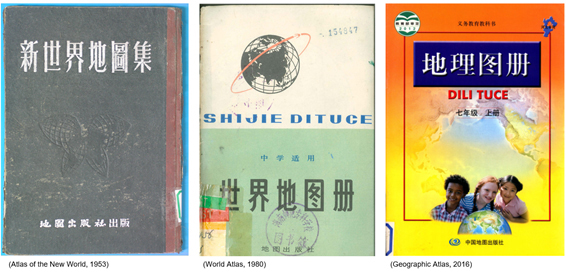In June 2022, I was looking for a project to conduct my GRP (Guided Research Project), which could be in the same field of my research interest. The project article, “Maps and Atlases as Mediators and Producers of Space (Knowledge) under the Global Condition” attracted me a lot and I contacted Dr Jana Moser immediately. I was ecstatic to receive a response from Jana within a few days and to meet with all my colleagues on this project, including Dr Philipp Meyer, who became my second supervisor. I joined the group as a guest researcher between October 2022 and March 2023. During this time, I completed my GRP and gave an academic presentation at IfL on “The Development of China’s School Atlases and the Cartographers of the Zou Family”.
The research was started from the literature review of the previous papers, including “From ‘All Under Heaven’ to ‘China in the World’: Chinese Visual Imaginations from the Nineteenth and Early Twentieth Centuries” by Laura Pflug (2019) and “A View from Inside: Chinese Mapping of the World Against the Backdrop of Colonial Experience” by Laura Pflug (2020). They gave me fresh viewpoints on the subject of mapping analysis. Since I have almost ten years of experience studying urban studies and planning, I am accustomed to creating maps based on current conditions or local history and analyzing specific spaces through mapping, which is a useful tool for an urban planner. However, the maps I came across now were produced from the perspectives of a cartographer rather than an urban planner, which has a different emphasis than how urban planners create maps. As a result, I expected to expand my professional expertise by obtaining a new lens for analyzing maps and atlases.
Based on a review of past academic works, I examined the analysis approach with a coding scheme, which unravels each atlas into three sections (containing Map Information, Signs, and Graphical/visual variable) with many branches covering all kinds of elements of the map. Throughout this process, I am grateful to Philipp, who met with me several times and answered many of my questions about my confusion. I completed coding schemes for three China’s School Atlases, produced in 1953, 1980, and 2016 respectively, under his guidance. This served as the foundation for both my future GRP and my final academic presentation at IfL.

I met with Jana and Philipp several times in March because there were too many clues to investigate, and I was confused about which of them would be the emphasis of my research. Finally, I decided to structure my presentation on cartographers in the field of modern mapping techniques in China since the Ming Dynasty, as well as the comparison of the School Atlases from 1953, 1980, and 2016, with a focus on the comparison relevant to political signs. As the history of the Cartographers of Zou Family is a special and an attractive research topic, it was contained in my research as a transitional part as well.

Finally, by April 3rd, I had completed my GRP report and had presented its main contents to my colleagues at IfL, allowing me to share my academic work with researchers from various backgrounds. Meanwhile, the participants and discussions provided me multiple helpful suggestions.
At the end of this brief article, I would like to thank Dr Jana Moser and Dr Philipp Meyer for their substantial contributions to my research throughout the process. Also, many thanks to Birgit Hölzel, who was extremely helpful to me during my time at IfL.
Shumiao Li is a master student in European Urban Studies at Bauhaus-Universität Weimar and did research as a guest researcher at IfL for half year with the funding from DAAD.
References:
Li, H. and Long, J. (eds) (1994) 隆回县志. 中国城市出版社.
